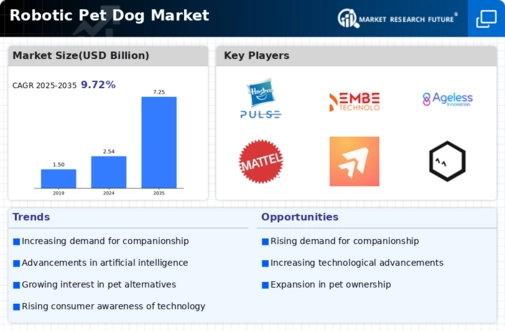Market Growth Projections
The Global Robotic Pet Dog Market Industry is poised for substantial growth, with projections indicating a market value of 7.25 USD Billion by 2035. This anticipated growth is underpinned by a compound annual growth rate of 10.01% from 2025 to 2035, reflecting the increasing consumer interest in robotic pets. Factors such as technological advancements, changing lifestyles, and the rising demand for companionship are likely to drive this expansion. As the market evolves, it is essential for stakeholders to monitor trends and adapt strategies to capitalize on emerging opportunities.
Expansion of E-commerce Platforms
The Global Robotic Pet Dog Market Industry benefits from the expansion of e-commerce platforms, which facilitate easier access to robotic pets for consumers worldwide. As online shopping continues to gain traction, consumers are increasingly turning to digital platforms to purchase innovative products. E-commerce allows for a broader reach, enabling manufacturers to connect with potential buyers across different geographical locations. This trend is likely to enhance market visibility and accessibility, driving sales growth. The convenience of online shopping, combined with targeted marketing strategies, positions the industry for sustained growth in the coming years.
Growing Awareness of Pet Allergies
The Global Robotic Pet Dog Market Industry is also influenced by the increasing awareness of pet allergies among consumers. Many individuals and families are unable to own traditional pets due to allergies, leading them to seek alternatives that provide similar companionship without the associated health risks. Robotic pets offer a viable solution, allowing allergy sufferers to enjoy the benefits of pet ownership without the discomfort. This shift in consumer behavior is likely to drive market growth, as more people recognize the advantages of robotic pets. The market's expansion reflects a broader trend towards inclusive pet ownership.
Increasing Demand for Companion Robots
The Global Robotic Pet Dog Market Industry experiences a surge in demand for companion robots, driven by the growing need for emotional support and companionship among individuals, particularly the elderly and those living alone. As societal structures evolve, the appeal of robotic pets as alternatives to traditional pets becomes more pronounced. In 2024, the market is valued at 2.54 USD Billion, reflecting a significant shift in consumer preferences towards robotic companions. This trend is likely to continue as advancements in artificial intelligence and robotics enhance the capabilities of these devices, making them more appealing to a broader audience.
Technological Advancements in Robotics
Technological advancements play a pivotal role in shaping the Global Robotic Pet Dog Market Industry. Innovations in artificial intelligence, machine learning, and robotics are enhancing the functionality and interactivity of robotic pets. These advancements enable robotic dogs to exhibit more lifelike behaviors, respond to commands, and engage in social interactions, thereby increasing their appeal. As these technologies continue to evolve, they are expected to attract a wider consumer base, contributing to the market's growth. The anticipated compound annual growth rate of 10.01% from 2025 to 2035 indicates a robust trajectory for the industry, driven by these technological improvements.
Rising Disposable Income and Consumer Spending
Rising disposable income levels across various regions contribute to the growth of the Global Robotic Pet Dog Market Industry. As consumers experience increased financial stability, they are more inclined to invest in innovative products that enhance their quality of life. Robotic pets, which combine entertainment and companionship, are becoming attractive options for families and individuals looking to enrich their living environments. This trend is expected to bolster market growth, with projections indicating that the market could reach 7.25 USD Billion by 2035. The correlation between disposable income and consumer spending on luxury items underscores the potential for continued expansion.




















